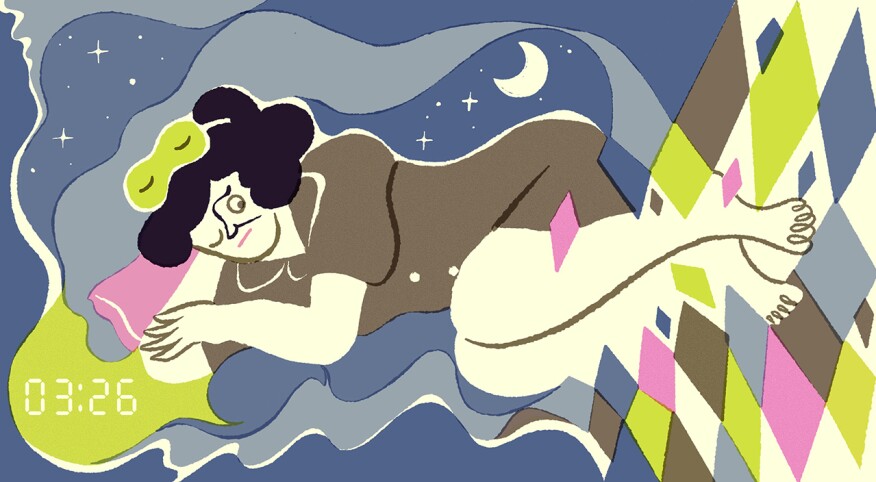You are lying in bed, trying to (finally) get a good night’s sleep, when suddenly it feels as if your calves are being seized in a vise grip, leaving you begging for mercy instead of slipping off into slumber. Consider it Mother Nature’s cruel joke. Just when you thought you were finished with cramps, they’re back. According to research conducted by the American Academy of Family Physicians, nocturnal leg cramps are reported by up to 60 percent of adults and are slightly more common in women. And as we age, they can become more prevalent.
Fariha Abbasi-Feinberg, M.D., Medical Director of Sleep Medicine at the Millennium Physician Group in Fort Myers, Florida, explains why this may be the case. “As we get older, we can lose muscle, and the remaining muscle can be more easily stressed. Peri- and postmenopausal hormonal changes may also play a role.”
While most nocturnal leg cramps are not serious, they can be a sign of underlying medical conditions, including diabetes, electrolyte abnormalities, certain neurological disorders, and liver and kidney disorders, according to Abbasi-Feinberg. “Medications for blood pressure such as diuretics can cause dehydration, which increases risk of cramp,” she says. “Other medications such as cholesterol-lowering agents are also often associated with nocturnal leg cramps.”
Some of the most common causes of nocturnal leg cramps, usually described as a spasming or hardening of the muscle, include dehydration, low electrolytes and lack of muscle tone. As with so many things, what you do during the day affects what happens at night. Lifestyle changes, including nutritional tweaks, exercise and, yes, even some seemingly odd remedies like pickle juice (we’ll get to that), can help. Be sure to consult with your doctor before engaging in any new exercise or diet routine or taking supplements.
“The best time to treat muscle cramps is before they occur,” says Mariam Zakhary, a doctor of osteopathic medicine and Medical Director Downtown for Rehabilitation and Human Performance at Mount Sinai in New York City. “Gaining strength and simply being active gets the muscle used to contracting and releasing, which helps prevent cramps.”
You don’t have to go hard-core. Walking and bike riding are great ways to condition leg muscles without impact. Even a stroll can make a difference. The trick is to find something you like and stick with it.
“Anything that your body is able to do pain-free is going to condition your joints and your muscles, and will help prevent cramps,” Zakhary says.
If your cramps tend to occur in your calves, she recommends doing simple heel raises. Stand behind a chair and rest your hands on top for balance while you raise your heels off the ground until you are on the balls of your feet, then slowly lower your heels. Repeat as many times as you can comfortably do, and build up daily.
Stretching is another effective way to loosen muscles and prevent cramps. “Before bed, try stretching your calves by standing about 3 feet away from a wall, then lean into the wall to stretch the back of the leg,” Abbasi-Feinberg advises.
If you do get a cramp while in bed, rather than getting up to walk it off, which may further interfere with sleep, she advises flexing your foot upward to stretch your calf until the cramp eases.
Staying hydrated is one of the most important steps you can take to avoid leg cramps, but be sure to space your liquid intake throughout the day. As most of us have experienced, drinking too much water before bed means more wake-up calls during the night to hit the bathroom.
Maintaining a good electrolyte balance is also key to prevention. While sports drinks can help with both hydration and electrolytes, there are plenty of other ways to get the magnesium and potassium contained in electrolytes. Zakhary recommends including leafy green vegetables, nuts, bananas, avocados and apricots in your diet as a first step. Magnesium supplements are also an option, but check with your doctor for dosage and for potential interactions with other drugs you may be taking.
Ask almost any woman who has experienced nighttime leg cramps what’s worked for her, and you’re bound to hear some suggestions that at first might sound a little nutty. One popular home remedy is pickle juice.
“It’s not as crazy as it sounds,” Zakhary says. “Pickle juice has electrolytes and sodium, so if dehydration is a cause, it can help.”
If you are monitoring your salt intake, however, pickle juice’s high sodium content may not be appropriate. Spicy mustard, another popular word-of-mouth recommendation, is also high in sodium. Both, if you can take the salt, are certainly worth trying.
Tonic water, on the other hand, is one home treatment that the FDA warns against. The quinine in it can cause side effects that range from interfering with certain medications to more serious blood platelet disorders.
Bottom line: After your post-dinner stroll to condition your muscles, consider trading milk and cookies for a spoonful of mustard washed down with pickle juice. It may not sound quite as appealing, but you might get a better night’s sleep.
Anyone suffer from leg cramps? What do you do about them? Let us know in the comments below.

Rozalina Burkova
Follow Article Topics: Health






